Class 6: Maths Chapter 14 solutions. Complete Class 6 Maths Chapter 14 Notes.
Contents
NCERT Solutions for 6th Class Maths: Chapter 14- Practical Geometry
NCERT 6th Maths Chapter 14, class 6 Maths Chapter 14 solutions
Exercise 14.1
1. Draw a circle of radius 3.2 cm.
Answer
Steps of construction:
(a) Open the compass for the required radius of 3.2 cm.
(b) Make a point with a sharp pencil where we want the centre of circle to be.
(c) Name it O.
(d) Place the pointer of compasses on O.
(e) Turn the compasses slowly to draw the required circle.
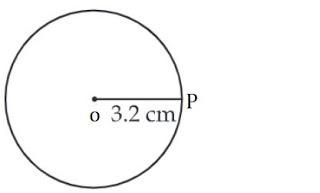
2. With the same centre O, draw two circles of radii 4 cm and 2.5 cm.
Steps of construction:
(a) Marks a point ‘O’ with a sharp pencil where we want the centre of the circle.
(b) Open the compasses 4 cm.
(c) Place the pointer of the compasses on O.
(d) Turn the compasses slowly to draw the circle.
(e) Again open the compasses 2.5 cm and place the pointer of the compasses on D.
(f) Turn the compasses slowly to draw the second circle.
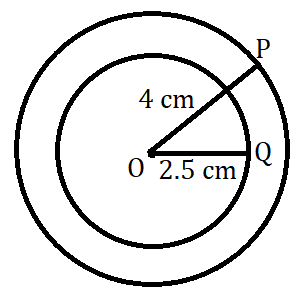
Hence, it is the required figure.
3. Draw a circle and any two of its diameters. If you join the ends of these diameters, what is the figure obtained? What figure is obtained if the diameters are perpendicular to each other? How do you check your answer?
Answer
(i) By joining the ends of two diameters, we get a rectangle. By measuring, we find AB = CD = 3 cm, BC = AD = 2 cm i.e., pairs of opposite sides are equal and also ∠A = ∠B = ∠C = ∠D = 90° i.e., each angle is of 90°.
Hence, it is a rectangle.
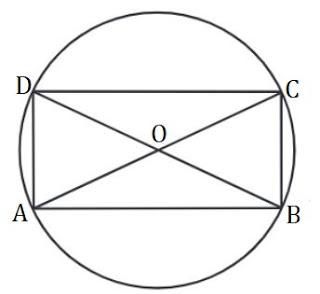
(ii) If the diameters are perpendicular to each other, then by joining the ends of two diameters, we get a square. By measuring, we find that AB = BC = CD = DA = 2.5 cm, i.e., all four sides are equal. Also ∠A = ∠B = ∠C = ∠D = 90°, i.e., each angle is of 90°.
Hence, it is a square.
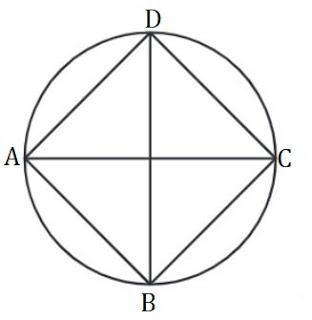
4. Draw any circle and mark points A, B and C such that:
(a) A is on the circle.
(b) B is in the interior of the circle.
(c) C is in the exterior of the circle.
Answer
(i) Mark a point ‘O’ with sharp pencil where we want centre of the circle.
(ii) Place the pointer of the compasses at ‘O’. Then move the compasses slowly to draw a circle.
(a) Point A is on the circle.
(b) Point B is in interior of the circle.
(c) Point C is in the exterior of the circle.
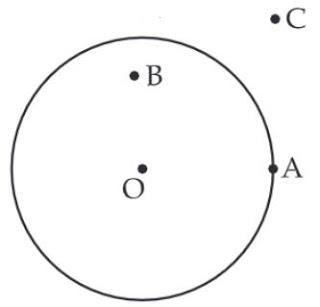
5. Let A, B be the centres of two circles of equal radii; draw them so that each one of them passes through the centre of the other. Let them intersect at C and D. Examine whether ![]() are at right angles.
are at right angles.
Answer
Draw two circles of equal radii taking A and B as their centre such that one of them passes through the centre of the other. They intersect at C and D. Join AB and CD.
Yes, AB and CD intersect at right angle as ∠COB is 90°.
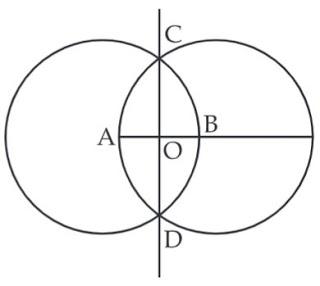
NCERT 6th Maths Chapter 14, class 6 Maths Chapter 14 solutions
Exercise 14.2
1. Draw a line segment of length 7.3 cm, using a ruler.
Steps of construction:
(i) Place the zero mark of the ruler at a point A.
(ii) Mark a point B at a distance of 7.3 cm from A.
(iii) Join AB.
Hence, ![]() is the required line segment of length 7.3 cm.
is the required line segment of length 7.3 cm.

2. Construct a line segment of length 5.6 cm using ruler and compasses.
Answer
(i) Draw a line ‘l’. l Mark a point A on this line.
(ii) Place the compasses pointer on zero mark of the ruler. Open it to place the pencil point up to 5.6 cm mark.
(iii) Without changing the opening of the compasses. Place the pointer on A and cut an arc ‘l’ at B. ![]() is the required line segment of length 5.6 cm.
is the required line segment of length 5.6 cm.

3. Construct ![]() of length 7.8 cm. From this, cut off
of length 7.8 cm. From this, cut off ![]() of length 4.7 cm. Measure
of length 4.7 cm. Measure ![]() .
.
Answer
(i) Place the zero mark of the ruler at A.
(ii) Mark a point B at a distance 7.8 cm from A.
(iii) Again, mark a point C at a distance 4.7 from A.
Hence, by measuring ![]() , we find that BC = 3.1 cm.
, we find that BC = 3.1 cm.

4. Given ![]() of length 3.9 cm, construct
of length 3.9 cm, construct ![]() such that the length of
such that the length of ![]() is twice that of
is twice that of ![]() . Verify by measurement.
. Verify by measurement.

(Hint: construct ![]() such that length of
such that length of ![]() = length of
= length of ![]() then cut off
then cut off ![]() such that
such that ![]() also has the length of
also has the length of ![]() .
.
Answer

(i) Draw a line ‘l’.
(ii) Construct ![]() such that length of
such that length of ![]() = length of
= length of ![]()
(iii) Then cut of ![]() such that
such that ![]() also has the length of
also has the length of ![]() .
.
(iv) Thus the length of ![]() and the length of
and the length of ![]() added together make twice the length of
added together make twice the length of ![]() .
.
Verification: Hence, by measurement we find that PQ = 7.8 cm
= 3.9 cm + 3.9 cm
= ![]() +
+ ![]() = 2 ×
= 2 × ![]() .
.
5. Given ![]() of length 7.3 cm and
of length 7.3 cm and ![]() of length 3.4 cm, construct a line segment
of length 3.4 cm, construct a line segment ![]() such that the length of
such that the length of ![]() is equal to the difference between the lengths of
is equal to the difference between the lengths of ![]() and
and ![]() . Verify by measurement.
. Verify by measurement.
Answer

(i) Draw a line ‘l’ and take a point X on it.
(ii) Construct ![]() such that length
such that length ![]() = length of
= length of ![]() = 7.3 cm.
= 7.3 cm.
(iii) Then cut off ![]() = length of
= length of ![]() = 3.4 cm.
= 3.4 cm.
(iv) Thus the length of ![]() = length of
= length of ![]() – length of
– length of ![]() .
.
Verification:
Hence, by measurement we find that length of ![]()
= 3.9 cm
= 73. cm – 3.4 cm
= ![]() –
– ![]() .
.
NCERT 6th Maths Chapter 14, class 6 Maths Chapter 14 solutions
Exercise 14.3
1. Draw any line segment ![]() . Without measuring
. Without measuring ![]() , construct a copy of
, construct a copy of ![]() .
.

(i) Given ![]() whose length is not known.
whose length is not known.
(ii) Fix the compasses pointer on P and the pencil end on Q. The opening of the instrument now gives the length of ![]() .
.
(iii) Draw any line ‘l’. Choose a point A on ‘l’. Without changing the compasses setting, place the pointer on A.
(iv) Draw an arc that cuts ‘l’ at a point, say B.
Hence, ![]() is the copy of
is the copy of ![]() .
.
2. Given some line segment ![]() whose length you do not know, construct
whose length you do not know, construct ![]() such that the length of
such that the length of ![]() is twice that of
is twice that of ![]() .
.
Answer

(i) Given ![]() whose length is not known.
whose length is not known.
(ii) Fix the compasses pointer on A and the pencil end on B. The opening of the instrument now gives the length of ![]() .
.
(iii) Draw any line ‘l’. Choose a point P on ‘l’. Without changing the compasses setting, place the pointer on Q.
(iv) Draw an arc that cuts ‘l’ at a point R.
(v) Now place the pointer on R and without changing the compasses setting, draw another arc that cuts ‘l’ at a point Q.
Hence, ![]() is the required line segment whose length is twice that of AB.
is the required line segment whose length is twice that of AB.
NCERT 6th Maths Chapter 14, class 6 Maths Chapter 14 solutions
Exercise 14.4
1. Draw any line segment ![]() . Mark any point M on it. Through M, draw a perpendicular to
. Mark any point M on it. Through M, draw a perpendicular to ![]() . (use ruler and compasses)
. (use ruler and compasses)
Answer
(i) Draw a line segment ![]() and mark a point M on it.
and mark a point M on it.
(ii) Taking M as centre and a convenient radius, construct an arc intersecting the line segment ![]() at points X and Y respectively.
at points X and Y respectively.
(iii) By taking centres as X and Y and radius greater than XM, construct two arcs such that they intersect each other at point D.
(iv) Join DM. Now ![]() is perpendicular to
is perpendicular to ![]() .
.
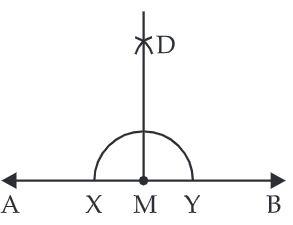
2. Draw any line segment ![]() . Take any point R not on it. Through R, draw a perpendicular to
. Take any point R not on it. Through R, draw a perpendicular to ![]() . (Use ruler and set-square)
. (Use ruler and set-square)
Answer
(i) Draw a given line segment ![]() and mark a point R outside the line segment
and mark a point R outside the line segment ![]() .
.

(ii) Place a set square on ![]() such that one of its right angles arm aligns along
such that one of its right angles arm aligns along ![]() .
.
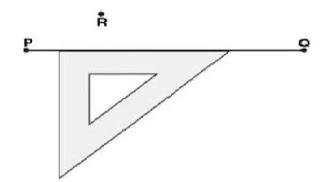
(iii) Now, place the ruler along the edge opposite to right angle of set square.
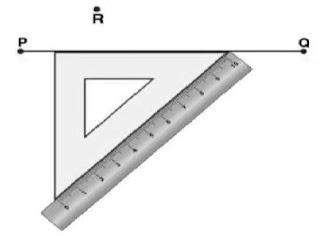
(v) Draw a line along this edge of set square which passes through point R. Now, it is the required line perpendicular to ![]() .
.
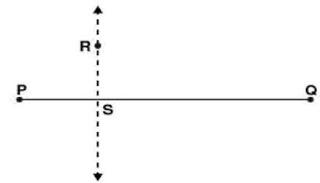
3. Draw a line l and a point X on it. Through X, draw a line segment ![]() perpendicular to l. Now draw a perpendicular to
perpendicular to l. Now draw a perpendicular to ![]() to Y. (use ruler and compasses)
to Y. (use ruler and compasses)
Answer
(i) Draw a line l and mark a point X on it.
(ii) By taking X as centre and with a convenient radius, draw an arc intersecting the line l at points A and B respectively.
(iii) With A and B as centres and a radius more than AX, construct two arcs such that they intersect each other at point Y.
(iv) Join XY. Here ![]() is perpendicular to l.
is perpendicular to l.
Similarly, by taking C and D as centres and radius more than CY, construct two arcs intersecting at point Z. Join ZY. The line ![]() is perpendicular to
is perpendicular to ![]() at Y.
at Y.
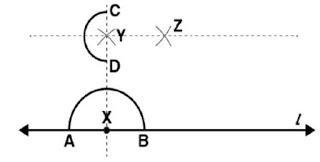
NCERT 6th Maths Chapter 14, class 6 Maths Chapter 14 solutions
Exercise 14.5
1. Draw ![]() of length 7.3 cm and find its axis of symmetry.
of length 7.3 cm and find its axis of symmetry.
(i) Draw a line AB of length 7.3 cm.
(ii) Take a point O as the mid-point of AB.
(iii) Draw OP perpendicular to AB
Thus, OP is a line of symmetry.
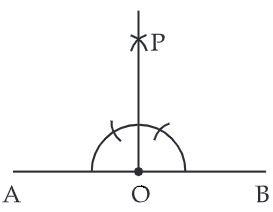
2. Draw a line segment of length 9.5 cm and construct its perpendicular bisector.
Answer
(i) Draw a line segment AB = 9.5 cm.
(ii) With A as centre and radius more than half of AB, draw an arc on both sides of AB.
(iii) With B as centre and the same radius as in step 2, draw an arc intersecting the arc drawn in step 2, at C and D.
(iv) Join CD intersecting AB at O. Then CD is the perpendicular bisector of AB.
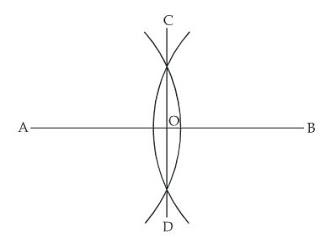
3. Draw the perpendicular bisector of ![]() whose length is 10.3 cm.
whose length is 10.3 cm.
(a) Take any point P on the bisector drawn. Examine whether PX = PY.
(b) If M is the mid-point of ![]() , what can you say about the lengths MX and XY?
, what can you say about the lengths MX and XY?
(i) Draw a line segment ![]() = 10.3 cm
= 10.3 cm
(ii) Taking X and Y as centres and radius more than half of AB, draw two arcs which intersect each other at C and D.
(iii) Join CD. Then CD is the required perpendicular bisector of ![]() .
.
Now:
(a) Take any point P on the bisector drawn. With the help of divider we can check that ![]() =
= ![]() .
.
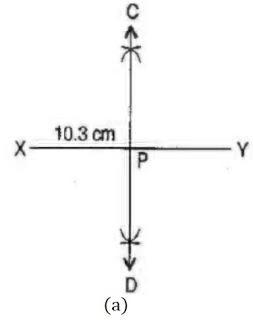
(b) If M is the mid-point of ![]() then
then ![]() = 1/2
= 1/2 ![]() .
.
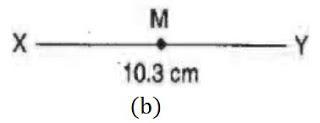
4. Draw a line segment of length 12.8 cm. Using compasses, divide it into four equal parts. Verify by actual measurement.
Answer
(i) Draw a line segment AB = 12.8 cm
(ii) Draw the perpendicular bisector of ![]() which cuts it at C. Thus, C is the midpoint of
which cuts it at C. Thus, C is the midpoint of ![]() .
.
(iii) Draw the perpendicular bisector of ![]() which cuts it at D. Thus D is the midpoint of.
which cuts it at D. Thus D is the midpoint of.
(iv) Again, draw the perpendicular bisector of ![]() which cuts it at E. Thus, E is the mid-point of
which cuts it at E. Thus, E is the mid-point of ![]()
(v) Now, point C, D and E divide the line segment ![]() in the four equal parts.
in the four equal parts.
(vi) By actual measurement, we find that ![]() =
= ![]() =
= ![]() =
= ![]() = 3.2 cm.
= 3.2 cm.
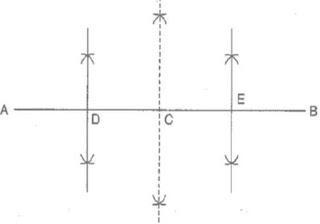
5. With ![]() of length 6.1 cm as diameter, draw a circle.
of length 6.1 cm as diameter, draw a circle.
Answer
(i) Draw a line segment ![]() = 6.1 cm.
= 6.1 cm.
(ii) Draw the perpendicular bisector of PQ which cuts, it at O. Thus O is the mid-point of ![]() .
.
(iii) Taking O as centre and OP or OQ as radius draw a circle where diameter is the line segment ![]() .
.
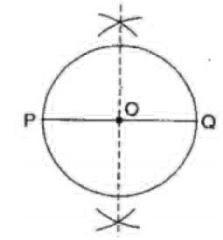
6. Draw a circle with centre C and radius 3.4 cm. Draw any chord ![]() . Construct the perpendicular bisector
. Construct the perpendicular bisector ![]() and examine if it passes through C.
and examine if it passes through C.
Answer
(i) Mark any point C on the sheet
(ii) Adjust the compasses up to 3.4 cm and by putting the pointer of compasses at point C, turn compasses slowly to draw the circle. This is the required circle of 3.4 cm radius.
(iii) Mark any chord ![]() in the circle.
in the circle.
(iv) Now, taking A and B as centres, draw arcs on both sides of ![]() . Let these intersect each other at points D and E.
. Let these intersect each other at points D and E.
(v) Join DE. Now DE is the perpendicular bisector of AB.
If ![]() is extended, it will pass through point C.
is extended, it will pass through point C.
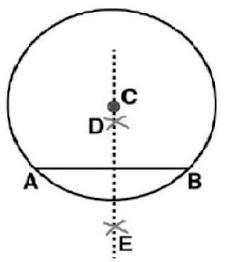
7. Repeat Question 6, if ![]() happens to be a diameter.
happens to be a diameter.
Answer
(i) Mark any point C on the sheet.
(ii) Adjust the compasses up to 3.4 cm and by putting the pointer of compasses at point C, Turn the compasses slowly to draw the circle. This is the required circle of 3.4 cm.
(iii) Now mark any diameter ![]() in the circle.
in the circle.
(iv) Now taking A and B as centres, draw arcs on both sides of ![]() with radius more than
with radius more than ![]() . Let these intersect each other at points D and E.
. Let these intersect each other at points D and E.
(v) Join DE, which is perpendicular bisector of AB.
Now, we may observe that ![]() is passing through the centre C of the circle.
is passing through the centre C of the circle.
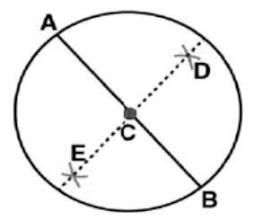
8. Draw a circle of radius 4 cm. Draw any two of its chords. Construct the perpendicular bisectors of these chords. Where do they meet?
Answer
(i) Mark any point C on the sheet. Now adjust the compasses up to 4 cm and by placing the pointer of compasses at point C, turn the compasses slowly to draw the circle. This is the required circle of 4 cm radius
(ii) Take any two chords ![]() and
and ![]() in the circle.
in the circle.
(iii) By taking A and B as centres and radius more than half of ![]() draw arcs on both sides of AB. The arcs are intersecting each other at point E and F. Join EF which is perpendicular bisector of AB.
draw arcs on both sides of AB. The arcs are intersecting each other at point E and F. Join EF which is perpendicular bisector of AB.
(iv) Again take C and D as centres and radius more than half of ![]() draw arcs on both sides of CD such that they are intersecting each other at points G, H. Join GH which is perpendicular bisector of CD.
draw arcs on both sides of CD such that they are intersecting each other at points G, H. Join GH which is perpendicular bisector of CD.
We may observe that when EF and GH are extended they meet at the point O, which is the centre of circle.
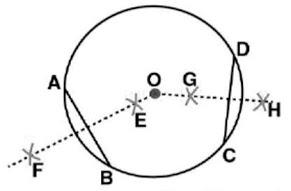
9. Draw any angle with vertex O. Take a point A on one of its arms and B on another such that OA = OB. Draw the perpendicular bisectors of ![]() and
and ![]() . Let them meet at P. Is PA = PB?
. Let them meet at P. Is PA = PB?
Answer
(i) Draw any angle with vertex as O.
(ii) By taking O as centre and with convenient radius, draw arcs on both rays of this angle. Let these points are A and B
(iii) Now take O and A as centres and with radius more than half of OA, draw arcs on both sides of OA. Let these intersects at points C and D respectively. Join CD
(iv) Similarly we may find ![]() which is perpendicular bisector of
which is perpendicular bisector of ![]() . These perpendicular bisectors
. These perpendicular bisectors ![]() and
and ![]() intersects each other at point P. Now measure PA and PB. They are equal in length.
intersects each other at point P. Now measure PA and PB. They are equal in length.
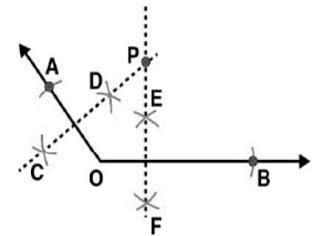
NCERT 6th Maths Chapter 14, class 6 Maths Chapter 14 solutions
Exercise 14.6
1. Draw ∠ POQ of measure 75° and find its line of symmetry.
Answer
(i) Draw a line l and mark a point O on it.
(ii) Place the pointer of the compasses at O and draw an arc of any radius which intersects the line l at A.
(iii) Taking same radius, with centre A, cut the previous arc at B.
(iv) Join OB, then ∠ BOA = 60 .
(v) Taking same radius, with centre B, cut the previous arc at C.
(vi) Draw bisector of ∠BOC. The angle is of 90 . Mark it at D. Thus, ∠DOA = 90°
(vii) Draw ![]() as bisector of ∠DOB. Thus, ∠POA = 75°.
as bisector of ∠DOB. Thus, ∠POA = 75°.
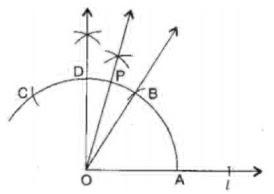
2. Draw an angle of measure 147° and construct its bisector.
Answer
The steps are followed to construct an angle of measure 147° and its bisector
(i) Draw a line l and mark point O on it. Place the centre of protractor at point O and the zero edge along line l
(ii) Mark a point A at an angle of measure 147°. Join OA. Now OA is the required ray making 147° with line l
(iii) By taking point O as centre, draw an arc of convenient radius. Let this intersect both rays of angle 1470 at points A and B.
(iv) By taking A and B as centres draw arcs of radius more than 1/2 AB in the interior angle of 147°. Let these intersect each other at point C. Join OC. OC is the required bisector of 147° angle.
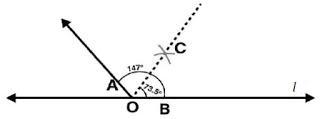
3. Draw a right angle and construct its bisector.
Answer
(i) Draw a line PQ and take a point O on it.
(ii) Taking O as centre and convenient radius, draw an arc which intersects PQ at A and B.
(iii) Taking A and B as centres and radius more than half of AB, draw two arcs which intersect each other at C.
(iv) Join OC. Thus, ∠COQ is the required right angle.
(v) Taking B and E as centre and radius more than half of BE, draw two arcs which intersect each other at the point D.
(vi) Join OD. Thus, ![]() is the required bisector of ∠COQ.
is the required bisector of ∠COQ.
4. Draw an angle of measure 153° and divide it into four equal parts.
Answer
The steps are followed to construct an angle of measure 153° and its bisector
(i) Draw a line l and mark a point O on it. Place the centre of protractor at point O and the zero edge along line l
(ii) Mark a point A at the measure of angle 153°. Join OA. Now OA is the required ray making 153° with line l
(iii) Draw an arc of convenient radius by taking point O as centre. Let this intersects both rays of angle 153° at points A and B.
(iv) Take A and B as centres and draw arcs of radius more than 1/2 AB in the interior of angle of 153°. Let these intersect each other at C. Join OC
(v) Let OC intersect major arc at point D. Draw arcs of radius more than 1/2 AD with A and D as centres and also D and B as centres. Let these are intersecting each other at points E and F respectively. Now join OE and OF
OF, OC, OE are the rays dividing 153° angle into four equal parts.
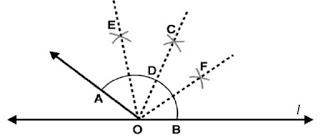
5. Construct with ruler and compasses, angles of following measures:
(a) 60°
(b) 30°
(c) 90°
(d) 120°
(e) 45°
(f) 135°
Answer
(a) 60°
(i) Draw a line segment OA.
(ii) With O as centre and any suitable radius draw an arc cutting OA at point D.
(iii) With D as centre and the same radius draw another arc cutting the previous arc at E.
(iv) Join OE and produce it to B. ZAOB = 60°.
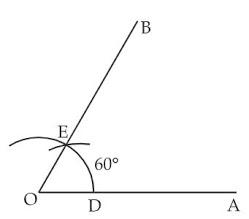
(b) 30°
(i) Draw a line segment OA.
(ii) With O as centre and any suitable radius draw an arc cutting OA at point C.
(iii) With C as centre and same radius as before draw another arc cutting the previous arc at E.
(iv) Join OE and produce it to B. ZAOB = 60°.
(v) Bisect ZAOB. Thus, ZAOM = ZMOB = 30°.
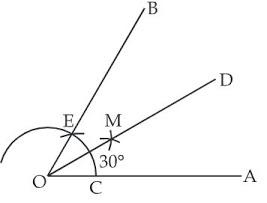
(c) 90°
(i) Draw a line segment OA.
(ii) With O as centre and any suitable radius draw an arc cutting OA at point C.
(iii) With Cas centre and same radius cut off the arc P and then with P as centre and the same radius cut off the arc again at Q.
(iv) With Pand Q as centres and any suitable radius or even the same radius draw arcs cutting each other at R.
(v) Join OR and produce it to B. Then ZAOB = 90°.
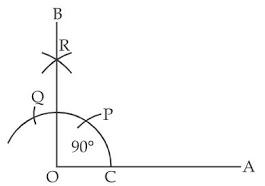
(d) 120°
(i) Draw a line segment OA.
(ii) With O as centre and any suitable radius draw an arc cutting OA at point M.
(iii) With M as centre and same radius draw an arc which cuts the arc at Nand then with Nas centre and the same radius cut off the arc again at Q.
(iv) Join OQ and produce it to B. Thus, ∠AOB = 120°.
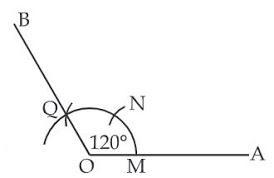
(e) 45°
(i) Draw a line segment OA.
(ii) With O as centre and any suitable radius draw an arc cutting OA at point C.
(iii) With C as centre and same radius cut off the arc at P and then with P as centre and the same radius cut off the arc again at Q.
(iv) With P and Q as centres and any suitable radius (more than half of PQ) or even the same radius draw arc cutting each other at R.
(v) Join OR and produce it to B. Then ∠AOB = 90°.
(vi) Bisect ∠AOB. 7. OD is the bisector of ∠AOB.
∴ ∠BOD = ∠DOA = 45°.
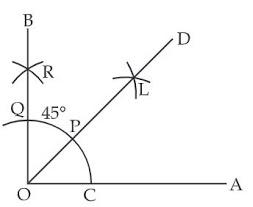
(f) 135°
(i) Draw a line segment OA.
(ii) With O as centre and any suitable radius draw an arc cutting OA at point C.
(iii) With C as centre and the same radius cut off the arc at P and then with P as centre and the same radius cut off the arc again at Q and then with Q as centre and the same radius cut off the arc again at R.
(iv) With Q and R as centres and radius more than half of RQ draw arcs cutting each other at L.
(v) Join OL and produce it to B. Then ∠AOB = 150°.
(vi) Take a point M on the arc where OL intersects the arc.
(vii) With M and Q as centres and radius more than half of MQ draw arcs cutting each other at N.
(viii) Join ON and produce it to E. Thus, ∠AOE = 135°.
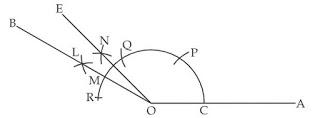
6. Draw an angle of measure 45° and bisect it.
Answer
(i) Draw a line segment OA.
(ii) With O as centre and any suitable radius draw an arc cutting OA at C.
(iii) With C as centre and same radius cut off the arc at P and then with P as centre and the same radius cut off the arc again at Q.
(iv) With P and Q as centres and radius more than half of PQ draw arcs cutting each other at R.
(v) Join OR and produce it to B. Then ∠AOB = 90°.
(vi) Bisect ∠AOB.
(vii) OD is the bisector of ∠AOB.
∠BOD = ZDOA = 45°.
(viii) Again draw OE bisector of ZDOA.
Thus, angle ∠DOE = ∠EOA = 22.5°.
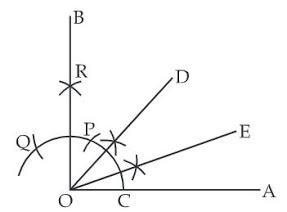
7. Draw an angle of measure 135° and bisect it.
The steps are followed to construct an angle of measure 135° and its bisector.
(i) By using a protractor ∠POQ of 135° measure may be formed on a line l
(ii) Draw an arc of convenient radius by taking O as centre. Let this intersect both rays of angle 135° at points A and B respectively.
(iii) Take A and B as centres, draw arcs of radius more than 1/2 AB in the interior of angle of 135°.
Let these intersect each other at C. Join OC.
OC is the required bisector of 135° angle.
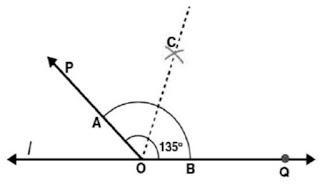
NCERT 6th Maths Chapter 14, class 6 Maths Chapter 14 solutions
NCERT Solutions for 6th Class Maths: Chapter 14: Download PDF
NCERT Solutions for 6th Class Maths: Chapter 14- Practical Geometry
Download PDF: NCERT Solutions for 6th Class Maths: Chapter 14- Practical Geometry PDF
Chapterwise NCERT Solutions for Class 6 Maths :
- Chapter 1 Knowing Our Numbers
- Chapter 2 Whole Numbers
- Chapter 3 Playing with Numbers
- Chapter 4 Basic Geometrical Ideas
- Chapter 5 Understanding Elementary Shapes
- Chapter 6 Integers
- Chapter 7 Fractions
- Chapter 8 Decimals
- Chapter 9 Data Handling
- Chapter 10 Mensuration
- Chapter 11 Algebra
- Chapter 12 Ratio and Proportion
- Chapter 13 Symmetry
- Chapter 14 Practical Geometry
About NCERT
The National Council of Educational Research and Training is an autonomous organization of the Government of India which was established in 1961 as a literary, scientific, and charitable Society under the Societies Registration Act. Its headquarters are located at Sri Aurbindo Marg in New Delhi. Visit the Official NCERT website to learn more.
